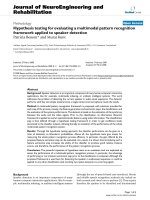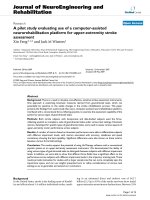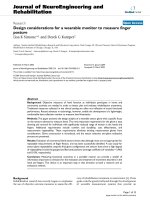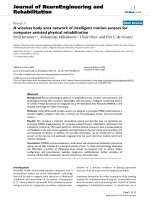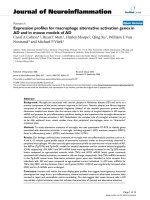Báo cáo hóa học: " Convergence theorem for finite family of lipschitzian demi-contractive semigroups" pptx
Bạn đang xem bản rút gọn của tài liệu. Xem và tải ngay bản đầy đủ của tài liệu tại đây (299.83 KB, 10 trang )
RESEA R C H Open Access
Convergence theorem for finite family of
lipschitzian demi-contractive semigroups
Bashir Ali
*
and Godwin Chidi Ugwunnadi
* Correspondence:
Department of Mathematical
Sciences, Bayero University, Kano,
Nigeria
Abstract
Let E be a real Banach space and K be a nonempty, closed, and convex subset of E.
Let
{J
i
}
N
i
=
1
be a finite family of Lipschitzian demi-contractive semigroups of K,with
sequences of bounded measurable functions L
i
: [0, ∞) ® (0, ∞) and bounded
functions l
i
: [0, ∞) ® (0, ∞), respectively, where
J
i
:= {T
i
(
t
)
: t ≥ 0
}
, i = 1,2, , N.
Strong convergence theorem for common fixed point for finite family
{J
i
}
N
i
=
1
is
proved in a real Banch space. As an application, a new convergence theorem for
finite family of Lipschitzian demi-contractive maps is also proved.
Mathematics subject classification (2000) 47H09, 47J25
Keywords: Demi-contractive maps, Demi-contractive semigroup, Demicompact
maps, Fixed point
1. Introduction
Let E be a real Banach space and E* be the dual space of E. The normalized duality
mapping
J
: E → 2
E
∗
is defined by, x Î E,
Jx =
{
x
∗
∈ E
∗
:
x, x
∗
=
||
x
|| ||
x
∗
||
,
||
x
∗
||
=
||
x
||},
where 〈., .〉 denotes the normalized duality pairing. For any x Î E, an element of
Jx is denoted by j(x).
Let K be a nonempty, closed and convex subset of E.LetT : K ® K be a map, a
point x Î K is called a fixed point of T if Tx = x, and the set of all fixed points of T is
denoted by F(T). The mapping T is called L-Lipschitzian or simply Lipschitz if ∃L>0,
such that ||Tx -Ty|| ≤ L||x - y|| ∀x, y Î K and if L = 1, then the map T is called
nonexpansive.
A one parameter family
J = {T
(
t
)
: t ≥ 0
}
of self mapping of K is called a nonexpan-
sive semigroup if the following conditions are satisfied,
(i) T(0)x = x ∀ x Î K;
(ii) T(t + s)=T(t) ∘ T(s) ∀ t, s ≥ 0;
(iii) for each x Î K, the mapping t ® T(t)x is continuos;
(iv) for x, y Î K and t ≥ 0, ||T(t)x -T(t)y|| ≤ ||x - y||.
If the family
J = {T
(
t
)
: t ≥ 0
}
satisfies conditions (i)-(iii), then it is called
(a) pseudocontractive semigroup if for any x, y Î K,thereexistsj(x - y) Î J(x - y)
such that
T
(
t
)
x − T
(
t
)
y, j
(
x − y
)
≤ ||x − y||
2
;
Ali and Ugwunnadi Fixed Point Theory and Applications 2011, 2011:18
/>© 2011 Ali and Ugwunnadi; licensee Springer. This is an Open Access article distributed under the terms of the Creative Common s
Attribu tion License ( which permits unrestricted use, distribution, and reproduction in
any medium, provided the original work is properly cited.
(b) strictly pseudocontractive semigroup if there exists a bounded function l :[0,∞) ®
(0, ∞) and j(x - y) Î J(x - y) such that
T
(
t
)
x − T
(
t
)
y, j
(
x − y
)
≤ ||x − y||
2
− λ
(
t
)
||
(
I − T
(
t
))
x −
(
I − T
(
t
))
y||
2
for all x, y Î K;
(c) demi-contractive semigroup if F(T(t)) ≠ ∅∀t ≥ 0, there exists a bounded function l :
[0, ∞) ® (0, ∞), and j(x - y) Î J(x - y) such that
T
(
t
)
x − q, j
(
x − q
)
≤ ||x − q||
2
− λ
(
t
)
||x − T
(
t
)
x||
2
for any x Î K and q Î F(T(t));
(d) Lipschitzian semigroup if there is a bounded measurable function
L : [0, ∞) ® (0, ∞) such that for x, y Î K and t ≥ 0,
||T
(
t
)
x − T
(
t
)
y|| ≤ L
(
t
)
||x − y||
.
It is known that every strictly pseudocontractive semigroup is Lipschitzian, and every
strictly pseudocontractive semigroup with fixed point is demi-contractive semi-group.
Let E be a real Banach space and let K be a nonempty closed convex subset of E.A
mapping T : K ® K is demicomp act if for every bounded sequence {x
n
}inK such that
{xn - Tx
n
} converges, and there exists a subsequence, say
{x
n
j
}
of {x
n
}thatconverges
strongly to some x*inK. T is said to be demi-contractive if F(T) ≠ ∅, and there exists l
>0 such that 〈Tx- q, j(x - q)〉 ≤ ||x - q||
2
- l||x - Tx||
2
∀ x Î K, q Î F(T)andj(x - q) Î J
(x - q).
Let T
1
, T
2
, , T
N
be a family of self-mappings of K such that
F := ∩
N
i
=1
F(T
i
) =
∅
.
Then, the family is said to satisfy condition
C
if there exists a nondecreasing function f
:[0,∞) ® [0, ∞)withf (0) = 0 and f (r ) >0 ∀ r Î (0, ∞) such that f (d(x, F)) ≤ ||x -
T
s
x|| for some s in {1, 2, , N} and for all x Î K, where d(x, F)=inf {||x - q|| : q Î F}.
Existence theorems for family of nonexpansive mappings a re proved in [1-5] and
actually many others. Recently, Suzuki [6] proved the equivalence between the fixed
point property for nonexpansive mappings and that of the nonexpansive semi-groups.
Both implicit and explicit, Mann, Ishikawa, and Halpern-typ e schemes we re studied
for approximation of common fixed points of family o f nonexpansive semigroups and
their generalizations in various spaces; see, for example [6-13], to list but a few.
In 1998, Shoiji and Takahashi [7] introduced and studied a Halpern- type sche me for
common fixed point of a family of asymptotically nonexpansive semigroup in the fra-
mework of a real Hilbert space. Suzuki [8] proved that the implicit scheme defined by
x, x
1
Î K,
x
n
= α
n
T
(
t
n
)
x
n
+
(
1 − α
n
)x
converges strongly to a common fixed point of the family of nonexpansive semigroup
in a real Hilbert space. Xu [9] extended the result of Suzuki to a more general real uni-
formly convex Banach space having a weakly sequentially continuous duality mapping.
In 2005, Aleyner and Reich [10] proved the strong convergence of an explicit Halpern-
type scheme defined by x, x
1
Î K,
x
n+1
= α
n
T
(
t
n
)
x
n
+
(
1 − α
n
)x
Ali and Ugwunnadi Fixed Point Theory and Applications 2011, 2011:18
/>Page 2 of 10
to a common fixed point of the family {T(t):t ≥ 0} of nonexpansive semigroup in a
reflexive Banach space with uniformly Gatéu ax differentiable norm. Recently, Zhang
et al. [11] introduced and studied a composite iterative scheme defined by x, x
1
Î K,
x
n+1
= α
n
y
n
+
(
1 − α
n
)
x; y
n
= β
n
T
(
t
n
)
x
n
+
(
1 − β
n
)
x
n
.
Those authors proved strong convergence of the sequence {x
n
} to a common fixed
point of the family {T(t):t ≥ 0} of nonexpansive semigroup.
Very recently, Chang et al. [12] proved a strong convergence theorem which
extended and improved the results in [10,9] and some others. They proved the follow-
ing theorem.
Theorem 1.1. Chang et al. [12]Let K be a nonempty, closed, and convex subset of a
real Banach space E: Let
J := {T
(
t
)
: t ≥ 0
}
be a Lipschitzian demi-contractive semi-
group of K with bounded measurable function L :[0,∞) ® (0, ∞) and bounded func-
tion l : [0, ∞) ® (0, ∞) such that
L := sup
t≥0
{L(t ) } < ∞, λ := inf
t
≥
0
{λ(t)} > 0andF :=
∩
t≥0
F(T(t )) = ∅
.
Let {t
n
} be an increasing sequence in [0, ∞) and {a
n
} be a sequence in (0,1) satisfying
the following conditions,
(i)
∞
n
=1
(1 − α
n
)=
∞
;(ii)
∞
n
=1
(1 − α
n
)
2
<
∞
. Assume that there exists a compact
subset C of E such that ∪
t≥0
T(t)(K) ⊂ C and for any bounded set D ⊂ K
lim
n→∞
sup
x∈D
,
s∈R
+
||T(s + t
n
)x − T(t
n
)x|| =0
.
Let {x
n
} be generated by x
1
Î K,
x
n+1
= α
n
x
n
+
(
1 − α
n
)
T
(
t
n
)
x
n
.
(1:1)
Then, the sequence {x
n
} converges strongly to some element in F.
Thepurposeinthisarticleistoproveastrong convergence theorem for common
fixed point for finite families
{
J
i
}
N
i
=
1
of demi-contractive semigroups in a real Banach
space. As application, we al so prove convergence theorem for finite family of demi-
contractive mappings. Our theorems generalize and improve several recent results. For
instance, Theorem 1.1, which generalized, extended and improved several recent
results, is a special case of our Theorem.
2. Preliminaries
We shall make use of the following lemmas.
Lemma 2.1. Let E be a real normed linear space. Then, the following inequality
holds:
||x + y||
2
≤||x||
2
+2y, j
(
x + y
)
, ∀ x, y ∈ Eandj
(
x + y
)
∈ J
(
x + y
).
Lemma 2.2. (Xu [14]) Let {a
n
}and{b
n
} be sequences of nonnegative real numbers
satisfying the inequality
a
n+1
≤
(
1+b
n
)
a
n
, n ≥ 1
.
If
∞
n
=1
b
n
<
∞
, then
lim
n
→∞
a
n
exists. If in addition {a
n
} has a subsequence which con-
verges strongly to zero, then
lim
n
→∞
a
n
=0
.
Ali and Ugwunnadi Fixed Point Theory and Applications 2011, 2011:18
/>Page 3 of 10
Lemma 2.3. (Suzuki [15]) Let {x
n
} and {y
n
} be bounded sequences in a Banach space E
and let {b
n
} be a sequence in [0, 1] with 0 <lim inf b
n
≤ lim supb
n
<1. Suppose x
n+1
=
b
n
y
n
+(1 -b
n
)x
n
for all integers n ≥ 1 and lim sup(||y
n+1
- y
n
|| - ||x
n+1
- x
n
||) ≤ 0. Then,
lim ||y
n
- x
n
|| = 0.
3. Main Results
Let E be a rea l Banach space, and K be a nonempty, closed convex subset of E. For
some fixed i Î N,let
J
i
:= {T
i
(
t
)
: t ≥ 0
}
be a Lipschitzian demi-contractive semi-
group with bounded measurable function L
i
:[0,∞) ® (0, ∞) and bounded function
l
i
:[0,∞) ® (0, ∞) such that
L
i
:= sup
t≥0
{L
i
(t )} < ∞, λ
i
:= inf
t
≥
0
{λ
i
(t )} > 0andF
i
:=
∩
t≥0
F(T
i
(t )) = ∅
.
Then, for x, y Î K, q Î F
i
and t ≥ 0,
T
i
(
t
)
x − q, j
(
x − q
)
≤||x − q||
2
− λ
i
||x − T
i
(
t
)
x||
2
and
|
|T
i
(
t
)
x − T
i
(
t
)
y|| ≤ L
i
||x − y||
.
Consider a family
{J
i
}
N
i
=
1
of Lipschitzian demi-contractive semigroups of K and let
L := max
1
≤
i
≤
N
{L
i
}
,
L := max
1
≤
i
≤
N
{L
i
}
and
λ := min
1
≤
i
≤
N
{λ
i
}
Clearly L<∞ and l >0andforx, y Î
K,
q
∈
F
, t ≥ 0 and any i Î {1, 2, , N},
T
i
(
t
)
x − q, j
(
x − q
)
≤||x − q||
2
− λ||x − T
i
(
t
)
x||
2
and
||T
i
(
t
)
x − T
i
(
t
)
y|| ≤ L||x − y||
.
For a fixed δ Î (0, 1) and t ≥ 0 define a family S
i
(t):K ® Ki= 1, 2, , N by
S
i
(
t
)
x :=
(
1 − δ
2
)
x + δ
2
T
i
(
t
)
x, ∀x ∈ K
.
(3:1)
Then, for x, y Î K and
q
∈
F
,
S
i
(t )x − q, j(x − q) =(1− δ
2
)x − q, j(x − q) + δ
2
T
i
(t )x − q , j(x − q)
≤ (1 − δ
2
)||x − q||
2
+ δ
2
[||x − q||
2
− λ||x − T
i
(t )x ||
2
]
= ||x − q||
2
− λδ
2
||x − T
i
(
t
)
x||
2
.
Let
¯
λ = λδ
2
> 0
,
then
S
i
(
t
)
x − q, j
(
x − q
)
≤ ||x − q||
2
−
¯
λ||x − T
i
(
t
)
x||
2
.
(3:2)
Also,
||S
i
(t )x − S
i
(t )y|| = ||(1 − δ
2
)(x − y)+δ
2
(T
i
(t )x − T
i
(t )y)|
|
≤ (1 − δ
2
)||x − y|| + δ
2
L||x − y||
=[1− δ
2
+ δ
2
L]||x − y||
≤
(
1+δ
2
L
)
||x − y||.
Let
¯
L =1+
δ
2
L
.
Ali and Ugwunnadi Fixed Point Theory and Applications 2011, 2011:18
/>Page 4 of 10
Then,
|
|S
i
(
t
)
x − S
i
(
t
)
y|| ≤
¯
L||x − y||
.
(3:3)
Hence, for each i Î {1, 2, N}, S
i
is Lipschitz with Lipschitz constant
¯
L >
0
.
Lemma 3.1. Let E be a real Banach space and K be a nonempty closed convex subset
of E. Let
{J
i
}
N
i
=
1
be a finite family of Lipschitzian demi-contractive semigroups of K with
sequences of bounded measurable functions L
i
:[0,∞) ® (0, ∞) and bounded functions
l
i
: [0, ∞) ® (0, ∞) i = 1, 2, , N such that for each i = 1, 2, , N,
L
i
:= sup
t≥0
{L
i
(t )} < ∞, λ
i
:= inf
t
≥
0
{λ
i
(t )} > 0andF
i
:=
∩
t≥0
F(T
i
(t )) = ∅
.
Let
F :=
∩
1
≤
i
≤
N
{
∩
t≥0
F(T
i
(t ))} =
∅
,{t
n
}be an increasing sequence in [0, ∞) and {a
n
} be a
sequence in (0,1) satisfying the following conditions:
(i)
∞
n
=1
(1 − α
n
)=
∞
, (ii)
∞
n
=1
(1 − α
n
)
2
<
∞
.
Assume ∀ i Î {1,2, , N} for any bounded set D ⊂ K the relation
lim
n→∞
sup
x∈D
,
s∈R
+
||T
i
(s + t
n
)x − T
i
(t
n
)x|| =
0
(3:4)
holds. Let {x
n
} be a sequence generated by x
1
Î K,
x
n+1
= α
n+1
x
n
+
(
1 − α
n+1
)
S
n+1
(
t
n+1
)
x
n
, n ≥
1
(3:5)
where T
n
(t
n
)=T
n modN
(t
n
).
Then,
(a)
lim
n
→∞
||x
n
− q|
|
exists for all
q
∈
F
.
(b)
lim inf
n
→∞
||x
n
− T
i
(t
n
)x
n
|| =
0
for all i Î {1,2,3, , N}.
Proof. For any fixed
q
∈
F
using (3.5), we have
x
n+1
− q =
(
x
n
− q
)
+
(
1 − α
n+1
)(
S
n+1
(
t
n+1
)
x
n
− x
n
).
Thus,
|
|x
n+1
− q||
2
= ||(x
n
− q)+(1− α
n+1
)(S
n+1
(t
n+1
)x
n
− x
n
)||
2
≤||x
n
− q||
2
+2(1− α
n+1
)S
n+1
(t
n+1
)x
n
− x
n
, j(x
n+1
− q)
= ||x
n
− q||
2
+2(1− α
n+1
)
S
n+1
(t
n+1
)x
n
− S
n+1
(t
n+1
)x
n+1
, j(x
n+1
− q)
+S
n+1
(t
n+1
)x
n+1
− q, j(x
n+1
− q)−x
n+1
− q, j(x
n+1
− q)
+x
n+1
− x
n
, j(x
n+1
− q)
≤||x
n
− q||
2
+2(1− α
n+1
)(
¯
L +1)||x
n
− x
n+1
||x
n+1
− q||
−2(1 − α
n+1
)
¯
λ||x
n+1
− T
n+1
(t
n+1
)x
n+1
||
2
≤||x
n
− q||
2
+2(1− α
n+1
)
2
(1 +
¯
L)
2
||S
n+1
(t
n+1
)x
n
− x
n
|| ||x
n
− q||
−2(1 − α
n+1
)
¯
λ||x
n+1
− T
n+1
(t
n+1
)x
n+1
||
2
≤||x
n
− q||
2
+2(1− α
n+1
)
2
(1 +
¯
L)
3
||x
n
− q||
2
−2(1 − α
n+1
)
¯
λ||x
n+1
− T
n+1
(t
n+1
)x
n+1
||
2
=(1+σ
n+1
)||x
n
− q||
2
− 2(1 − α
n+1
)
¯
λ||x
n+1
− T
n+1
(t
n+1
)x
n+1
||
2
≤
(
1+σ
n+1
)
||x
n
− q||
2
,
(3:6)
Ali and Ugwunnadi Fixed Point Theory and Applications 2011, 2011:18
/>Page 5 of 10
where
σ
n+1
=2
(
1+
¯
L
)
3
(
1 − α
n+1
)
2
.
Since
∞
n
=1
(1 − σ
n+1
)
2
<
∞
, by lemma 2.2, it follows that
lim
n
→∞
||x
n
− q|
|
exists.
Hence, {x
n
} is bounded, which implies that {T
n
(t
n
)x
n
} and {S
n
(t
n
)x
n
} are also bounded.
From (3.6)
||x
n+1
− q||
2
≤||x
n
− q||
2
+2(1− α
n+1
)
2
(1 +
¯
L)
3
||x
n
− q||
2
−2(1 − α
n+1
)
¯
λ||x
n+1
− T
n+1
(t
n+1
)x
n+1
||
2
≤||x
n
− q||
2
− 2
(
1 − α
n+1
)
¯
λ||x
n+1
− T
n+1
(
t
n+1
)
x
n+1
||
2
+2
(
1 − α
n+1
)
2
M
,
where,
M := (1 +
¯
L)
3
sup
n
∈
N
(||x
n
− q||
2
)
. Hence, for some m Î N,
2
¯
λ
m
n=1
(1 − α
n+1
)||x
n+1
− T
n+1
(t
n+1
)x
n+1
||
2
≤
m
n=1
(||x
n
− q||
2
−||x
n+1
− q||
2
)
+2M
m
n=1
(1 − α
n+1
)
2
≤||x
1
− q||
2
+2M
m
n
=1
(1 − α
n+1
)
2
< ∞.
Since m Î N is arbitrary, we have
2
¯
λ
∞
n
=1
(1 − α
n+1
)||x
n+1
− T
n+1
(t
n+1
)x
n+1
||
2
<
∞
which implies
lim inf
n
→∞
||x
n+1
− T
n+1
(t
n+1
)x
n+1
|| =0
.
(3:7)
Next, we show that,
lim
n
→
∞
||x
n+1
− x
n
|| =0
.
Let {b
n
}and{y
n
} be two sequences define by b
n
:= δ(1 - δ)a
n+1
+ δ
2
and
y
n
:=
x
n+1
−x
n
+β
n
x
n
β
n
. Then, using the definition of {b
n
}and{S
n
}weobtainthat
y
n
:=
δα
n+1
x
n
+δ
2
(1−α
n+1
)T
n+1
(t
n+1
)x
n
β
n
. Then,
y
n+1
− y
n
=
δα
n+2
β
n+1
[x
n+1
− x
n
]+δ
α
n+2
β
n+1
−
α
n+1
β
n
x
n
+
δ
2
(1 − α
n+2
)
β
n+1
[T
n+2
(t
n+2
)x
n+1
− T
n+2
(t
n+2
)x
n
]
+ δ
2
1 − α
n+2
β
n+1
−
1 − α
n+1
β
n
T
n+2
(t
n+2
)x
n
+
δ
2
(1 − α
n+1
)
β
n
[T
n+2
(t
n+2
)x
n
− T
n+1
(t
n+1
)x
n
].
Ali and Ugwunnadi Fixed Point Theory and Applications 2011, 2011:18
/>Page 6 of 10
Therefore,
|
|y
n+1
− y
n
|| − ||x
n+1
− x
n
|| ≤
δα
n+2
β
n+1
+
δ
2
L(1 − α
n+2
)
β
n+1
− 1
||x
n+1
− x
n
||
+ δ
α
n+2
β
n+1
−
α
n+1
β
n
||x
n
||
+ δ
2
1 − α
n+2
β
n+1
−
1 − α
n+1
β
n
||T
n+2
(t
n+2
)x
n
||
+
δ
2
(1 − α
n+1
)
β
n
||T
n+2
(t
n+2
)x
n
− T
n+1
(t
n+1
)x
n
||
.
Hence,
lim sup
n
→∞
(||y
n+1
− y
n
|| − ||x
n+1
− x
n
||) ≤ 0,
and by lemma 2.3,
lim
n
→
∞
||y
n
− x
n
|| =0
.
Thus,
|
|x
n+1
− x
n
|| = β
n
||
y
n
− x
n
|| → 0 as n →∞
.
This implies that,
||
x
n+i
− x
n
||
→ 0 as n →∞, ∀ i ∈
{
1, 2, 3, , N
}.
But, for i Î {1,2,3, , N},
|
|x
n
− S
n+i
(t
n+i
)x
n
|| ≤ δ
2
||x
n
− x
n+i
|| + ||x
n+i
− T
n+i
(t
n+i
)x
n+i
||
+ ||T
n+i
(t
n+i
)x
n+i
− T
n+i
(t
n+i
)x
n
||
≤ δ
2
[
(
1+L
)
||x
n+i
− x
n
|| + ||x
n+i
− T
n+i
(
t
n+i
)
x
n+i
||]
.
Therefore,
lim inf
n
→∞
||x
n
− S
n+i
(t
n+i
)x
n
|| =0
.
Hence,
lim inf
n→∞
||T
n+i
(t
n+i
)x
n
− x
n
|| = lim inf
n→∞
[
1
δ
2
||S
n+i
(t
n+i
)x
n
− x
n
||]=0
.
From the relation,
|
|T
n+i
(t
n
)x
n
− x
n
|| ≤ ||T
n+i
(t
n
)x
n
− T
n+i
((t
n+i
− t
n
)+t
n
)x
n
||
+||T
n+i
(t
n+i
)x
n
− x
n
||
≤ sup
z∈
{
x
n
}
,s∈R
+
||T
n+i
(t
n
)z − T
n+i
(s + t
n
)z|| + ||T
n+i
(t
n+i
)x
n
− x
n
||
,
and condition (3.4) we get
lim inf
n
→∞
||T
n+i
(t
n
)x
n
− x
n
|| =0
.
(3:8)
It follows from (3.8) that
lim inf
n
→
∞
||T
l
(t
n
)x
n
− x
n
|| =0∀ l ∈{1, 2, 3, , N
}
.Thiscom-
pletes the proof. □
Ali and Ugwunnadi Fixed Point Theory and Applications 2011, 2011:18
/>Page 7 of 10
Theorem 3.2. Let E, K,
F
,{a
n
}, {t
n
},
{J
i
}
N
i
=
1
and {x
n
} be as in lemma 3.1. Assume that,
for at least one i Î {1, 2, , N}, there exi sts a compact subset C of E such that ∪
t≥0
T
i
(t)
(K) ⊂ C. Then, the sequence {x
n
} converges to some element
F
.
Proof. By Lemma 3.1, we have
lim inf
n
→∞
||T
l
(t
n
)x
n
− x
n
|| =0∀ l ∈{1, 2, 3, , N
}
.
If ∪
t≥0
T
s
(t)(K) ⊂ C for some compact subet C of E and some s Î {1,2, ,N}, then
there exists a subsequence
{x
n
k
}
,of{x
n
} and q* Î K, such that
x
n
k
→ q
∗
and ||T
s
(t
n
k
)x
n
k
− x
n
k
|| → 0asn →∞
.
(3:9)
Observe that for t>0,
|
|T
s
(t )x
n
k
− x
n
k
|| ≤ ||T
s
(t )x
n
k
− T
s
(t )T
s
(t
n
k
)x
n
k
||
+ ||T
s
(t )T
s
(t
n
k
)x
n
k
− T
s
(t
n
k
)x
n
k
|| + ||T
s
(t
n
k
)x
n
k
− x
n
k
||
≤||T
s
(t + t
n
k
)x
n
k
− T
s
(t
n
k
)x
n
k
|| +(1+L) ||T
s
(t
n
k
)x
n
k
− x
n
k
||
.
From the above we have
lim
k
→∞
||T
s
(t )x
n
k
− x
n
k
|| =
0
. Using (3.9) and the fact that Ts is
Lipschitzian, we get q* Î ∩
t≥0
F(T
s
(t)).
Now, for any l Î {1,2, ,N }, since
lim inf
k
→
∞
||T
l
(t
n
k
)x
n
k
− x
n
k
|| =
0
, there exists a subse-
quence
{x
n
k
j
}
of
{x
n
k
}
such that
lim
j
→∞
||T
l
(t
n
k
j
)x
n
k
j
− x
n
k
j
|| = lim inf
k→∞
||T
l
(t
n
k
)x
n
k
− x
n
k
|| =
0
.Then,similarlyfort ≥ 0, we
obtain
|
|T
l
(t )x
n
k
j
− x
n
k
j
|| ≤ ||T
l
(t )x
n
k
j
− T
l
(t )T
l
(t
n
k
j
)x
n
k
j
||
+||T
l
(t )T
l
(t
n
k
j
)x
n
k
j
− T
l
(t
n
k
j
)x
n
k
j
|| + ||T
l
(t
n
k
j
)x
n
k
j
− x
n
k
j
||
≤||T
l
(t + t
n
k
j
)x
n
k
j
− T
l
(t
n
k
j
)x
n
k
j
|| +(1+L) ||T
l
(t
n
k
j
)x
n
k
j
− x
n
k
j
||
.
This implies that
lim
j
→∞
||T
l
(t )x
n
k
j
− x
n
k
j
|| =
0
and hence q* Î ∩
t≥0
F(T
l
(t)). Since l Î {1,
2, N} is arbitrarily chosen, we have
q
∗
∈
F
.Asthelimit
lim
n
→∞
||x
n
− q
∗
|
|
exists, the
conclusion of the theorem follows immediately and this completes the proof. □
Remark 3.3. Observe that considering a single one-parameter family of demi-contrac-
tive semigroup in Theorem 3.2, we obtain the conclusion of Theorem 1.1.
Let T
1
, T
2
, , T
N
be a finite family of Lipschitzian demi-contractive self-mapping of
K with positive constants l
1
, l
2
, , l
N
and Lipschitz constants L
1
,L
2
, , L
N
,
respectively. Let
F :=
∩
1
≤
i
≤
N
F(T
i
) =
∅
.
For a fixed δ Î (0, 1), define S
n
: K ® K by
S
n
x :=
(
1 − δ
2
)
x + δ
2
T
n
x, ∀ x ∈ K
.
(3:10)
Then, it follows that for x, y Î K and i Î F,
S
n
x − q, j(x − q)≤||x − q||
2
−
¯
λ||x − T
n
x||
2
an
d
||S
n
x − S
n
y
|| ≤
¯
L||x −
y
||,
where
¯
λ = λδ
2
>
0
,
¯
L =1+
δ
2
L
,
λ := m
i
n
1
≤
i
≤
N
{λ
i
}
and
L := max
1
≤
i
≤
N
{L
i
}
.
The following Theorem is a consequence of Lemma 3.1.
Theorem 3.4. Let E, K and {a
n
} be as in Lemma 3.1. Let T
1
, T
2
, , T
N
: K ® Kbe
Lipschitzian demi-contractive mappings with T
s
demicompact for at least one s Î {1, 2,
Ali and Ugwunnadi Fixed Point Theory and Applications 2011, 2011:18
/>Page 8 of 10
, N}. Let {x
n
] be a sequence generated by x
1
Î K
x
n+1
= α
n+1
x
n
+
(
1 − α
n+1
)
S
n+1
x
n
,
(3:11)
where T
n
= T
nmodN
. Then,{x
n
} converges strongly to a common fixed point of the
family
{T
i
}
N
i
=
1
.
Proof. Following the line of proof of lemma 3.1 we immediat ely obtain
lim
n
→∞
||x
n
− q|
|
qk exists for any q Î F and
lim inf
n
→
∞
||T
i
x
n
− x
n
|| =
0
, ∀i Î {1,2, . N}. Let
{
x
n
k
}
be a subsequence of {x
n
} such that
lim
k
→∞
||T
i
x
n
k
− x
n
k
|| = lim inf
n→∞
||T
i
x
n
− x
n
|| =0
.
Therefore
lim
k
→∞
||T
s
x
n
k
− x
n
k
|| =0
and, by demicompactness of T
s
, there exists a sub-
sequence
{x
n
k
j
}
of
{x
n
k
}
and q* Î K, such that
x
n
k
j
→ q
∗
as j ® ∞.
Since,
0 = lim
j→∞
||T
i
x
n
k
j
− x
n
k
j
|| = ||T
i
lim
j→∞
x
n
k
j
− lim
j→∞
x
n
k
j
|
|
= ||T
i
q
∗
−
q
∗
||,
we obtain q* Î F.But,
lim
n
→∞
||x
n
− q
∗
|
|
exists, thus x
n
® q* Î F and this completes
the proof. □
The following corollaries follow from Theorem 3.4
Corollary 3.5. Let E, Kand{a
n
} be as in Th eorem 3.4. Let T
1
, T
2
, ,T
N
: K ® Kbe
Lipschitzian demi-contractive mappings. Suppose there exists a comp act subset C in E
such that
N
∪
i
=1
T
i
(K) ⊂
C
. Let {x
n
} be defined by (3.11). Then,{x
n
} converges strongly to a
common fixed point of the family
{T
i
}
N
i
=
1
.
Corollary 3.6. Let E; K and {a
n
} be as in Th eorem 3.4. Let T
1
, T
2
, ,T
N
: K ® Kbe
Lipschitzian demi-contractive mappings satisfying condition
C
. Let {x
n
} be defined by
(3.11). Then,{x
n
} converges strongly to a common fixed point of the family
{T
i
}
N
i
=
1
.
Proof. Following the line of proof of lemma 3.1, we obtain
lim inf
n
→
∞
||x
n
− T
i
x
n
|| =
0
for
all i Î {1,2,3, ,N}and||x
n+1
- q||
2
≤ (1 + s
n+1
)||x
n
- q||
2
,where
σ
n+1
=2
(
1+
¯
L
)
3
(
1 − α
n+1
)
2
.Since
∞
n
=1
(1 − σ
n+1
)
2
<
∞
, by lemma 2.2
lim
n
→∞
||x
n
− p|
|
exists and consequently
lim
n
→∞
d(x
n
, F
)
exists. Let
{
x
n
k
}
be a subsequence of {x
n
}such
that
lim
k
→∞
||x
n
k
− T
i
x
n
k
|| = lim inf
n→∞
||x
n
− T
i
x
n
|| =
0
. Then, by using condition
C
,there
exists s Î {1,2, ,N} such that
0 = lim
k
→
∞
||x
n
k
− T
s
x
n
k
|| ≥ lim
k
→
∞
f (d(x
n
k
, F)
)
and, using
the property of f, we get that
lim
k
→∞
d(x
n
k
, F)=
0
, and since the limit
lim
n
→∞
d(x
n
, F
)
exists
we have that
lim
n
→∞
d(x
n
, F)=0
. We next s how that {x
n
} is Cauchy. Let ε >0begiven,
then there exists p* Î F and n* Î N such that ∀n ≥ n*,
||x
n
− p
∗
|| <
ε
2
. Hence, for n ≥
n* and k Î N, we have
|
|x
n+k
− x
n
|| ≤ ||x
n+k
− p
∗
|| + ||x
n
− p
∗
|
|
<ε
.
Thus, {x
n
} is Cauchy and so x
n
® q* Î K.Wenowshowthatq*isinF.Since
lim
n
→∞
d(x
n
, F)=0
, there exists m
0
Î N large enough and p* Î F such that for all n ≥ m
0
,
Ali and Ugwunnadi Fixed Point Theory and Applications 2011, 2011:18
/>Page 9 of 10
and
|
|x
n
− p
∗
|| <
ε
6
(
1+L
)
.Hence,
||q
∗
− T
l
q
∗
|| ≤ ||x
n
− q
∗
|| + ||x
n
− p
∗
|| + ||p
∗
− T
l
q
∗
|
|
≤
ε
6(1 + L)
+
ε
6(1 + L)
+ L||p
∗
− q
∗
||
<
ε
6(1 + L)
+
ε
6(1 + L)
+
3Lε
6(1 + L)
<
ε.
Thus, q* Î F(T
l
)andsincel Î {1,2, ,N} is arbitrary, we have q* Î F.Thiscom-
pletes the proof. □
Acknowledgements
This study was conducted when the first author was visiting the AbdusSalam International Center for Theoretical
Physics Trieste Italy as an Associate, and the hospitality and financial support provided by the centre is gratefully
acknowledged.
Authors’ contributions
BA conceived the study, GCU carried out the computations for Theorem 3.4. BA Modified Theorem 3.4 to obtain
Theorem 3.2. Both authors read and approved the final manuscript.
Competing interests
The authors declare that they have no competing interests.
Received: 6 March 2011 Accepted: 23 July 2011 Published: 23 July 2011
References
1. Belluce, LP, Kirk, WA: Fixed point theorem for families of contraction mappings. Pacific J Math. 18, 213–217 (1966)
2. Browder, FE: Nonexpansive nonlinear operators in Banach space. Proc Natl Acad Sci USA. 54, 1041–1044 (1965).
doi:10.1073/pnas.54.4.1041
3. Bruck, RE: A common fixed point theorem for a commuting family of nonexpansive mappings. Pacific J Math. 53,
59–71 (1974)
4. De Marr, R: Common fixed points for commuting contraction mappings. Pacific J Math. 13, 1139–1141 (1963)
5. Lim, TC: A fixed point theorem for families of nonexpansive mappings. Pacific J Math. 53, 487–493 (1974)
6. Suzuki, T: Fixed point property for nonexpansive mappings versus that for nonexpansive semigroups. Nonlinear Anal.
70, 3358–3361 (2009). doi:10.1016/j.na.2008.05.003
7. Shoiji, N, Takahashi, W: Strong convergence theorem for asymptotically nonexpansive semi-groups in Hilbert spaces.
Nonlinear Anal. 34,87–99 (1998). doi:10.1016/S0362-546X(97)00682-2
8. Suzuki, T: On strong convergence to a common fixed point of nonexpansive semigroups in Hilbert spaces. Proc Am
Math Soc. 131, 2133–2136 (2003). doi:10.1090/S0002-9939-02-06844-2
9. Xu, HK: Strong convergence theorem for contraction semigroups in Banach spaces. Bull Austal Math Soc. 72, 371–379
(2005). doi:10.1017/S000497270003519X
10. Aleyner, A, Reich, S: An explicit construction of sunny nonexpansive retraction in Banach spaces. Fixed Point Theory
Appl. 3, 295–305 (2005)
11. Zhang, SS, Yang, L, Liu, JA: Strong convergence theorem for nonexpansive semigroups in Banach spaces. Appl Math
Mech. 28, 1287–1297 (2007). doi:10.1007/s10483-007-1002-x
12. Chang, SS, Cho, YJ, Lee, HWJ, Chan, C: Strong convergence theorems for Lipschitzian demicontraction semigroups in
Banach spaces, Fixed Point Theory Application. (2011)
13. Zhang, SS: Convergence theorem of common fixed points for Lipshitzian pseudocontraction semigroups in Banach
spaces. Appl Math Mech. 30, 145–152 (2009). doi:10.1007/s10483-009-0202-y
14. Xu, HK: Inequalities in Banach spaces with applications. Nonlinear Anal. 16, 1127–1138 (1991). doi:10.1016/0362-546X(91)
90200-K
15. Suzuki, T: Strong convergence of Krasnoselskii and Mann’s type sequences for one-parameter nonexpansive semigroups
without Bochner integrals. J Math Anal Appl. 305, 227–239 (2005). doi:10.1016/j.jmaa.2004.11.017
doi:10.1186/1687-1812-2011-18
Cite this article as: Ali and Ugwunnadi: Convergence theorem for finite family of lipschitzian demi-contractive
semigroups. Fixed Point Theory and Applications 2011 2011:18.
Ali and Ugwunnadi Fixed Point Theory and Applications 2011, 2011:18
/>Page 10 of 10




